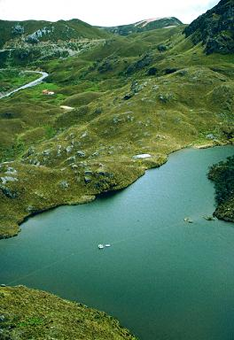NOAA/WDS Paleoclimatology - Abrupt Holocene climate transitions in the northern North Atlantic region recorded by synchronized lacustrine records in Iceland
This archived Paleoclimatology Study is available from the NOAA National Centers for Environmental Information (NCEI), under the World Data Service (WDS) for Paleoclimatology. The associated NCEI study type is Lake. The data include parameters of paleolimnology with a geographic location of Iceland, Northern Europe. The time period coverage is from 10300 to -56 in calendar years before present (BP). See metadata information for parameter and study location details. Please cite this study when using the data.
- Cite as: Geirsdóttir, A.; Miller, G.H.; Larsen, D.J.; Ólafsdóttir, S. (2014-02-25): NOAA/WDS Paleoclimatology - Abrupt Holocene climate transitions in the northern North Atlantic region recorded by synchronized lacustrine records in Iceland. [indicate subset used]. NOAA National Centers for Environmental Information. https://doi.org/10.25921/6q40-1m71. Accessed [date].
- Please refer to Credit tab for full citation information.
- doi:10.25921/6q40-1m71
- noaa-lake-16279
- NCEI DSI 1200_02
- NCEI DSI 1200_01
noaa-lake-16279
| Search Data |
|
| Download Data |
|
| Distribution Formats |
|
| Ordering Instructions | Contact NCEI for other distribution options and instructions. |
| Distributor | NOAA National Centers for Environmental Information
ncei.info@noaa.gov |
| Dataset Point of Contact | NOAA National Centers for Environmental Information
ncei.info@noaa.gov |
| Dataset Point of Contact | Data Center Contact
NOAA World Data Service for Paleoclimatology 828-271-4800 paleo@noaa.gov |
| Coverage Description | Date Range: 10300 cal yr BP to -56 cal yr BP; |
| Time Period | -8350 to 2006 |
| Spatial Bounding Box Coordinates |
N: 65.055846
S: 64.613723
E: -19.843769
W: -21.625757
|
| Spatial Coverage Map | |
| General Documentation |
|
| Associated Resources |
|
| Publication Dates |
|
| Data Presentation Form | Digital table - digital representation of facts or figures systematically displayed, especially in columns
|
| Dataset Progress Status | Complete - production of the data has been completed |
| Data Update Frequency | Data update frequency not available |
| Supplemental Information |
STUDY NOTES: Keywords - Iceland, Lake sediment, Holocene paleoclimate, Abrupt climate transitions, 8.2 Event, Holocene Thermal Maximum, Neoglaciation, Medieval warm period, Little Ice Age, geochemistry, carbon isotopes.
ABSTRACT SUPPLIED BY ORIGINATOR: Two high-sediment-accumulation-rate Icelandic lakes, the glacial lake Hvítárvatn and the non-glacial lake Haukadalsvatn, contain numerous tephra layers of known age, which together with high-resolution paleomagnetic secular variations allow synchronization with a well-dated marine core from the shelf north of Iceland. A composite standardized climate record from the two lakes provides a single time series that efficiently integrates multi-proxy data that reflect the evolution of summer temperatures through the Holocene. The first-order trends in biogenic silica (BSi), d13C, and C:N rise relatively abruptly following deglaciation, reaching maximum values shortly after 8 ka following a complex minimum between 8.7 and 8.0 ka. The Holocene Thermal Maximum (HTM) in the lakes is marked by all proxies, with a sharp transition out of the 8 ka cold event into peak summer warmth by 7.9 ka, and continuing warm with some fluctuations until 5.5 ka. Decreasing summer insolation after the HTM is reflected by incremental cooling, initially ~5.5 ka, with subsequent cold perturbations recorded by all proxies 4.3 to 4.0 ka and 3.1 to 2.8 ka. The strongest disturbance occurred after 2 ka with initial summer cooling occurring between 1.4 and 1.0 ka, followed by a more severe drop in summer temperatures after 0.7 ka culminating between 0.5 and 0.2 ka. Following each late Holocene cold departure, BSi re-equilibrated at a lower value independent of the sediment accumulation rate. Some of the abrupt shifts may be related to Icelandic volcanism influencing catchment stability, but the lack of a full recovery to pre-existing values after the perturbation suggests increased periglacial activity, decreased vegetation cover, and glacier growth in the highlands of Iceland. The similarity in timing, direction and magnitude of our multi-proxy records from glacial and non-glacial lakes, and from the adjacent marine shelf, suggests that our composite record reflects large-scale shifts in ocean/atmosphere circulation throughout the northern North Atlantic. |
| Purpose | Records of past climate and environment derived from lake sediment records. Parameter keywords describe what was measured in this dataset. Additional summary information can be found in the abstracts of papers listed in the dataset citations. |
| Dataset Citation |
|
| Cited Authors |
|
| Originators |
|
| Publishers |
|
| Theme keywords | Global Change Master Directory (GCMD) Science Keywords
|
| Data Center keywords | Global Change Master Directory (GCMD) Data Center Keywords
|
| Place keywords |
|
| Use Constraints |
|
| Access Constraints |
|
| Fees |
|
Last Modified: 2024-01-19
For questions about the information on this page, please email: ncei.info@noaa.gov
